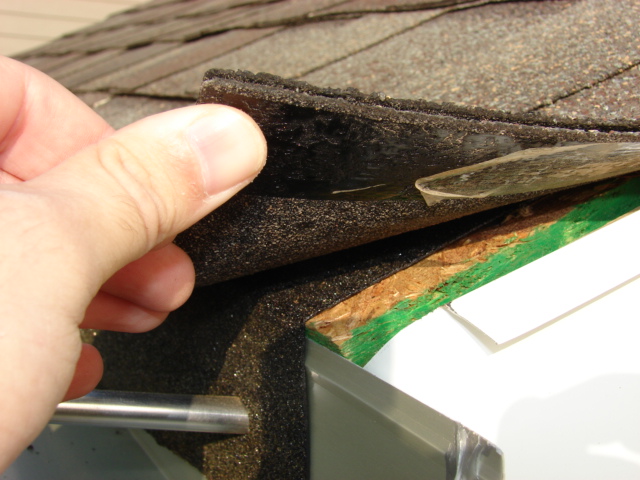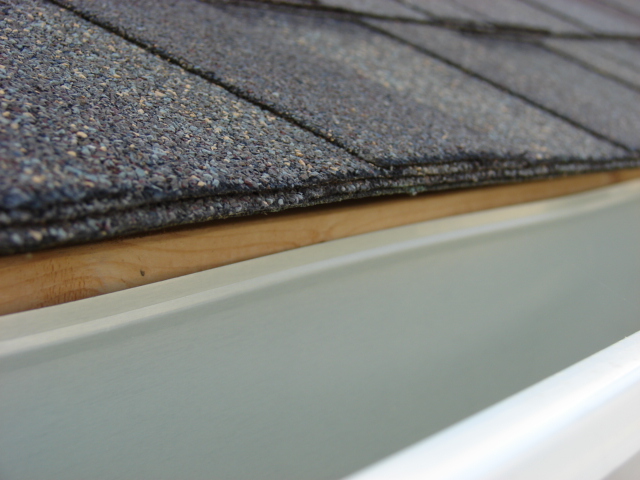Thanks for your help Kenton! Are there any manufacturers that would prohibit or void a the warranty for this installation. The shingles were obviously not cut properly and is very unsightly but does it affect performance?

Thanks for your help Kenton! Are there any manufacturers that would prohibit or void a the warranty for this installation. The shingles were obviously not cut properly and is very unsightly but does it affect performance?

Sorry Shawn, I can’t really tell from the photo. It looks like shingles don’t align at the valley, but the pitches might be different or the exposures might be incorrect. You’d need to check what substrate they’re installed over, lift a few tabs to see if they offset shingle courses correctly, if they’re nailed correctly, if they’re sealed at the adhesive strip, etc.
You’d want to re-seal any adhesive strip you break during the inspection to avoid liability for repair if they’re later blown off due to failure to re-seal properly (a strong possibility this time of year.)
Here’s the answer from the insurance company expert:
I’ll put this in the simplest terms, although every case is different. If
there is something that is causing a leak within the first few years (just
because no one has noticed doesn’t mean that it hasn’t been leaking) it is
usually installation-related. If the roof wears out prematurely it is
usually manufacturing-related, however, that failure can be hastened by a
faulty design or implementation of the attic ventilation system. The more
heat that is retained in the attic the sooner that shingle will wear out,
regardless of whether there is a manufacturing defect or not. Both good and poor products will last longer of the attic is properly ventilated.
In the most basic terms, you are usually going to know about an install
issue within the first couple years. That’s why some residential roofing
companies choose to offer a 10+ year warranty on their labor. People think it means they must be really sure of their work, when in fact the companies just realize that if something was done wrong, 99% of the time it will be identified in the first year or two when it would have been covered under a standard warranty.
From a major shingle manufacturer:
Unfortunately, that information is not available to us.
Is Ice Guard an adequate substitute for drip edge flashing? 






No, but it’s better than nothing. ![]()
Like the other side of that house. ![]()

Is there a site/link that has a list of approved flashings and appropriate location/installation details
That is sad, Bill, for lack of spending a couple hundred dollars for drip edge.
Picture four doesn’t even look like ice and water shield.
What quality!:roll:
I don’t know if this one may help.
Maybe Kenton can use it.
http://www.a-actionhomeinspection.com/library/Build%20A%20Better%20Home%20-%20Roofs.pdf
Marcel ![]()
A lot of sites have a few, or common flashing details.
Architectural Graphic Standards has quite a few. The SMACNA has a lot too, but they both charge for them.
InterNACHI is getting ready to put together a collection of details, including flashing, but two other projects have priority.
Thanks Marcel, I saw that one, but a lot of what I saw there I’ve never seen used in actual practice.
Looks like bituthene.
15# felt is used after you drink 15 beers of course, the same for 30# for 30 beers
I see mineral surface in pic 4…
:mrgreen::mrgreen::mrgreen::mrgreen:
Peter, after 15, I think they care about the weight of the paper felt. ![]()
30# is recommended by experienced roofers because you don’t feel the pain when you hit the ground.
Quote:
Originally Posted by kbraun http://nachi.cachefly.net/forum/images/2006/buttons/viewpost.gif
Is the ice shield applied over or under the drip edge? Rake edge?
Over on the eve, under on the rake.
Ice and water shield should be applied under the drip edge and a few inches down the fascia/gutter board and behind the gutter. This protects the fascia board / roof sheathing intersection from ice and water backup. You can always put a small strip over the drip for extra protection.
http://roofersreview.com/v/Roofing+Illustrated/Roof+Edge+Detail/
hope that helps
Dennis
Dennis, here are the drawings from their site which seem to show the membrane over the metal, but the Grace tech I spoke with told me it didn’t matter. She said you could run the Ice & Water Shield first, install the drip edge, then install a narrow strip over the uphill side of the drip edge to seal it, or install the drip edge first and lap the Ice & Water Shield over the top.
http://www.na.graceconstruction.com/custom/underlayments/graphics/iwsdet_101.gif
« Return to Index of Detail Drawings](http://www.na.graceconstruction.com/template.cfm?page=/underlayments/roofing_drawings.html&did=8)
http://www.na.graceconstruction.com/custom/underlayments/graphics/iwsdet_102.gif
http://www.na.graceconstruction.com/custom/underlayments/graphics/iwsdet_103.gif
http://www.na.graceconstruction.com/custom/underlayments/graphics/iwsdet_104.gif
« Return to Index of Detail Drawings](http://www.na.graceconstruction.com/template.cfm?page=/underlayments/roofing_drawings.html&did=8)
« Return to Index of Detail Drawings](http://www.na.graceconstruction.com/template.cfm?page=/underlayments/roofing_drawings.html&did=8)
Installed correctly and kept protected it doesn’t make any difference. 30# will resist damage better during installation of the roof-covering mateial and protect the roof longer if for some reason it should become exposed to weather.
Kenton,
Does extractive bleeding, or bleed-through, on asphalt shingles reduce the life of the roof? How about staining from black algae?
Thanks,
Dean Conrad